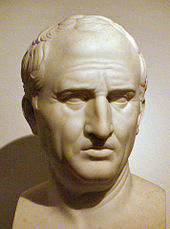De legibus

De legibus was a philosophical work of the Roman writer Marcus Tullius Cicero (106–43 BC). It was a supplement to the earlier work De re publica .
Time of origin
The exact date on which the work was written is unknown. However, in addition to numerous other references to historical events, Cicero also mentions his position as Augur (II, 31), which he demonstrably dates back to 53 BC. Chr. Held. In addition, the death of Clodius († 52 BC) is alluded to. This period can therefore serve as the terminus post quem for the writing of the work. It cannot, however, go back to 46 BC. BC, which emerges from Cicero's letters to Brutus . It is therefore assumed that Cicero was born at the end of 53 BC. Began with the drafting, but this at the beginning of 51 BC. BC (he left for the province) and did not publish the work.
Shape and scope
De legibus was evidently a supplement to 51 BC. AD published. De re publica thought. It takes the form of a dialogue between Cicero, his brother Quintus and his friend Atticus in Arpinum . It stands in the tradition of Plato's double work Politeia and Nomoi .
Three books have survived. A fourth is announced in the third book and a fifth is quoted in a fragment by Macrobius . As with Plato, the dialogue should last a whole day. After Book V, lunchtime is reached, so more books were probably planned.
content
In De re publica , Cicero had explained the best state , while he now intended to deal with the best laws . These should be derived from human nature.
Book I introduces a Stoic- inspired theory of "laws of nature" according to which the true law corresponds to divine reason. Since all human beings are also gifted with reason, by training their mind they can ultimately participate in divine reason and live according to the true, eternal law.
These philosophical thoughts are taken up again in Book II. In particular, it is made clear that there are false laws in the world that do not apply by nature and therefore do not actually deserve the designation "law". This is followed by a religious framework law ( constitutio religionum ), which is heavily inspired by the Roman tradition.
Finally, in Book III, a corresponding collection of laws on the magistrate is drawn up. The laws are each written in an ancient style and each of the two collections is followed by a commentary in which the presented laws are treated with varying degrees of depth. The concrete laws take up the Roman tradition with some recourse to Plato rather than the theory of natural law explained in the first book.
Book IV apparently contained an addition to Book III, possibly on the judiciary . The content of Book V can hardly be reconstructed. However, it can be assumed that, as with Plato, further areas of law should be discussed.
Lore
Dialogue is hardly mentioned in ancient texts; Exceptions are Macrobius , Lactantius and Augustine . In the 5th century it was included in the corpus from which the two Vossiani originate and only passed on for posterity in this way.
Text editions and translations
- Jonathan GF Powell (Ed.): M. Tvlli Ciceronis De re pvblica. De legibvs. Cato maior de senectvte. Laelivs de amicitia, Oxford 2006. (Text-critical edition)
- Andrew R. Dyck: A commentary on Cicero, De legibus, Ann Arbor 2004. (Comment)
- M. Tullius Cicero: De legibus / About the laws. Latin and German. Ed., Trans. and ext. by Rainer Nickel , Düsseldorf ²2002.
literature
- Robert Philippson : M. Tullius Cicero. In: Paulys Realencyclopadie der classischen Antiquity Science (RE). Volume VII A, 1, Stuttgart 1939, Sp. 1117-1121.
- Gustav Adolf Lehmann : Political Reform Proposals in the Crisis of the Late Roman Republic. Cicero, De legibus III and Sallust's letters to Caesar, Meisenheim am Glan 1980.
- Klaus Martin Girardet : The order of the world. A contribution to the philosophical and political interpretation of Cicero's De legibus, Wiesbaden 1983.
- Inga Meyer: From vision to reform. The state of law: Cicero's program for a reorganization of the Roman Republic 56–51 BC Chr., Munich 2006.
Web links
- Latin text
- German translation - by Johann Michael Heinze, 1788